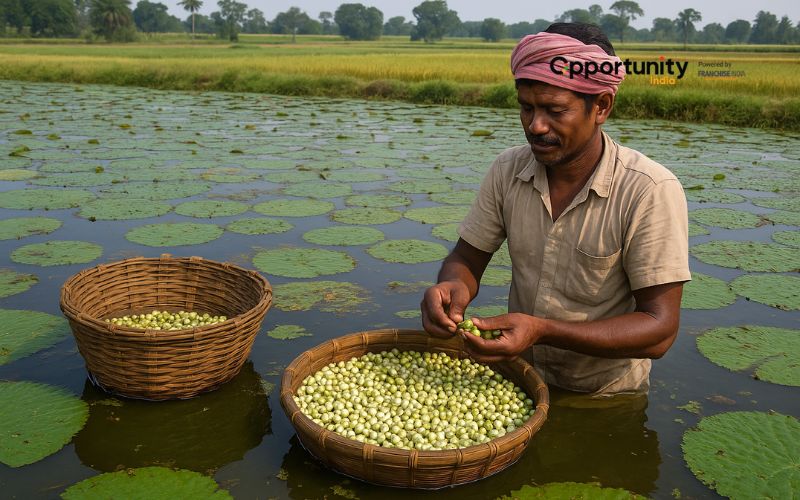
If you have ever added roasted makhanas to your kheer or crunched on a handful healthy snack, you are already familiar with this nutritious superfood. However, did you know that in India makhana farming can be a very profitable agribusiness? An increasing number of entrepreneurs are investigating this possibility as demand increases in both domestic and international markets. Makhana farming may be the answer for you if you're an agri-enthusiast seeking a specialized business or a farmer seeking to diversify. This article will explain the makhana farming procedure, how much investment needed, and a detailed guide for starting a profitable makhana cultivation business.
Makhana Farming Business in India: A Market Overview
Makhanas, sometimes referred to as lotus seeds or fox nuts, are derived from the Euryale ferox plant, a kind of water lily that grows in still water. The famous snack we see in the stores today is made from these seeds, which are gathered, dried, and roasted. India now leads the world in both production and exports of makhana, which was once a regional delicacy. You might be surprised to know that it is now a multibillion-dollar industry due to rising domestic and worldwide demand.
Also Read: Top 5 Horticulture Business Ideas in India 2025
With over 80% of the world's makhana produced in Bihar, India is the world's leading producer and consumer. Commercial makhana cultivation is particularly well-known in the Mithilanchal region, which includes Darbhanga, Madhubani, and Saharsa. This modest aquatic crop, which is mostly grown in Indian ponds and marshes, especially in Bihar, is becoming more than just a traditional snack. It is a growing industry with enormous potential for investors and farmers.
In 2024, the Indian makhana market was valued at INR 8.5 billion. According to IMARC Group's forecast, the market would increase at a compound annual growth rate (CAGR) of 9.22% from 2025 to 2033, reaching INR 19.6 billion. Some of the main reasons propelling the industry include the growing number of hotels, cafes, bakeries, and restaurants. The growing influence of food blogging channels; and people's growing knowledge of the advantages of eating healthy snacks is also a key drive.
With a high-carb, high-fiber, low-fat content and a wealth of vital minerals including potassium, phosphorus, iron, zinc, and magnesium, makhana is a better option than traditional snacks. Its low glycemic index and anti-inflammatory and anti-aging qualities make it even more appealing to health-conscious customers around the globe.

Why is Makhana Farming Business a Good Opportunity?
Makhana farming in India offers a great opportunity because of its distinct nutritional profile, gluten-free status, and adaptability in a variety of culinary uses.
Rising Demand for Healthy Snacks
The increasing demand for low-calorie, healthful snacks is a major factor in makhana farming's success. Since more people are becoming interested in fitness and wellness, makhana has become popular because of its high protein, low fat, and antioxidant-rich composition. It's frequently promoted as a roasted, gluten-free substitute for namkeen and chips. The market potential of makhana, both in India and elsewhere, has been greatly increased by the growing consumer demand in wholesome snacks.
Also Read: Pig Farming in India: Business Plan, Process & Investment
Export Possibilities and Global Appeal
Makhana is now available worldwide in health food markets and is no longer solely a Bihar specialty. Makhana's nutritional advantages have led to its importation into nations such as the USA, UK, Canada, Australia, and Japan. The potential for exporting makhana is rising along with awareness of Indian superfoods, giving farmers and business owners new ways to reach international markets. Profitable outcomes can result from satisfying international quality standards and building a high-quality supply chain.
Perfect for Low-Lying Areas
Makhana farming works best in low-lying, moist places like ponds, lakes, or seasonal tanks, as opposed to standard crops that need flat, dry landscape. Makhana farming makes these places productive and profitable, yet they are frequently neglected or unused. This technique enables farmers to make money from land that could otherwise be wasted because India has large areas of these types of water bodies, particularly in Bihar, Assam, and portions of West Bengal.
Employment and Rural Livelihoods
The process of growing and processing makhana requires a lot of work, especially when it comes to harvesting and popping. For local communities, particularly in rural areas, this generates job opportunities. In order to promote inclusive economic development, women and young people can receive training in popping, sorting, and packaging tasks. Makhana farming can create rural livelihoods and halt migration to cities as demand increases and processing facilities grow.
Government Assistance and Subsidies
With a number of initiatives and financial support programs, the Indian government is aggressively pushing makhana farming, especially in Bihar. Farmers can get assistance with pond rehabilitation, seed procurement, and training through the Mission for Integrated Development of Horticulture (MIDH) and Rastriya Krishi Vikas Yojana (RKVY).
Eco-friendly and sustainable farming
Finally, makhana farming is seen as an environmentally responsible and sustainable method of farming. It depends on water bodies and doesn't significantly contribute to pollution or soil deterioration. It is appropriate for long-term environmental sustainability since it fits well within the context of organic and climate-resilient agricultural methods, because the majority of the inputs are organic, and there is little automation involved.
Also Read: Poultry Egg Farming Business Plan: Detailed Guide
Step-by-Step Process of Makhana Farming
Preparing the Pond (January–February)
- Clean the pond and remove any dirt.
- Get rid of aquatic plants and weeds.
- Add organic manure to improve soil fertility, such as decomposed cow dung.
Sowing of Seeds (February–March)
- For each acre, use 80–100 kg of dry makhana seeds.
- In shallow seas, seeds are manually dispersed.
- Within 15 to 20 days, germination starts.

Development and Maintenance (March-May)
- On the surface of the river, broad leaves float.
- Weeds should be regularly inspected and cleaned.
- Most farming is organic, therefore, chemical fertilizers are not needed.
Also Read: Pearl Farming in India – Process and Investment Cost
Fruiting and Flowering (April–June)
- Fruits grow and plants bloom underwater.
- There are several black makhana seeds in each fruit.
Harvesting (June–August)
- Expert workers dive into the pond to gather seeds.
- The procedure is labor-intensive and laborious.
Processing (August-September)
There are four main steps in processing:
- Cleaning and Drying: Seeds are cleaned and allowed to dry for two to three days in the sun.
- Roasting: To harden the shell, roast in iron pans at high heat.
- Cracking/Popping: A wooden hammer is used to manually crack seeds.
- The appetizing white makhana emerges from the shell.
- Packed for retail or wholesale use.
Take note: To guarantee excellent quality and less waste, skilled labor is necessary for popping.
Also Read: Bamboo Farming Business in India: Process, Investment, and Profit
The Future of Makhana in India
Makhana cultivation in India appears to have a very promising future. Makhana is well-positioned for substantial expansion due to the growing global awareness of nutritious and useful foods, government assistance, and continuing research.
- Value Addition: Roasted and flavored makhana snacks, makhana flour, makhana bars, and even desserts made from makhana are becoming more popular. Profitability is raised and market opportunities are diversified as a result.
- Mechanization: Harvesting and processing machinery is being introduced to decrease the need for manual labor, increase productivity, and improve farmer safety.
- Market Expansion: With growing export possibilities to new countries outside of the traditional USA, UK, and UAE, India seeks to firmly establish itself as the global leader in makhana production and commerce.
- Sustainable Practices: Encouraging methods of sustainable agriculture will guarantee both environmental preservation and the long-term sustainability of makhana farming.
Wrapping Up
Makhana farming is becoming an attractive economic potential in India and is no longer only a traditional practice in rural Bihar. Makhana cultivation has the potential to generate long-term economic success, rural employment, and sustainable revenue with the correct preparation, training, and a little bit of creativity. Whether you are a business hoping to start a healthy food brand or a farmer with idle ponds, makhana could be the most suitable option.

